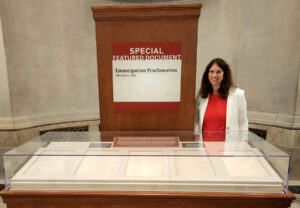Galena Marks the War’s End
The East Coast doesn’t have a monopoly on commemorating the Civil War’s conclusion. You’ll find special exhibits and presentations throughout the nation, including the Midwest. For example, The Galena-Jo Daviess County Historical Society in Galena, Ill., is hosting a bevy of Sesquicentennial exhibits and performances this April as part of “Galena Remembers.” Galena—named one of the nation’s most beautiful towns in 2014—can boast being home to not just Union General and President Ulysses S. Grant but also to eight other generals: Brev. Maj. Gen. Augustus L. Chetlain, Brev. Brig. Gen. John O. Duerr, Brig. Gen. Jasper A. Maltby, Brev. Brig. Gen. Ely S. Parker, Maj. Gen. John A. Rawlins, Brev. Brig. Gen. William R. Rowley, Brev. Brig. Gen. John C. Smith and Maj. Gen. John E. Smith. Thomas Nast’s oil painting Peace in Union, which depicts Grant shaking hands with Robert E. Lee, was presented to Galena’s citizens in 1895 and serves as the centerpiece of this year’s celebratory events. On offer will be a play, Peace in Union, art exhibits and a Civil War band performance. See GalenaHistoryMuseum.org for details.
Ford’s Theatre
Observations of the 150th anniversary of Abraham Lincoln’s assassination at Ford’s Theatre, which kicked off in January, will continue until late May. Ford’s will host an around-the clock event, “The Lincoln Tribute,” on April 14-15, which will include a candlelight vigil outside the theater on 10th Street in Washington, D.C. James Swanson, author of Manhunt: The 12-Day Chase to Catch Lincoln’s Killer, leads a midnight tour of Ford’s on April 14, and guided tours of the theater are offered on May 3 and May 17.
A special exhibition, “Silent Witnesses: Artifacts of the Lincoln Assassination,” will also be on display at the nearby Center for Education and Leadership (514 10th Street, N.W.) until May 25. Among featured artifacts are Lincoln’s top hat, cuff buttons and Brooks Brothers Great Coat and the contents of his pockets. Ford’s will also present a one-act play about the assassination titled One Destiny until May 16. For more information, go to fords.org
Booth Symposium
The 150th of Lincoln’s assassination is the inspiration for a symposium “Tudor Hall, the Booths of Maryland and the Civil War 2015,” to take place May 9 at the Bel Air Armory. Tours of Tudor Hall (see P. 34) will be on offer to attendees. Participating will be authors Terry Alford (Fortune’s Fool, see P. 31), Daniel Watermeier (American Tragedian: The Life of Edwin Booth), Jim Garrett (The Lincoln Assassination: Where Are They Now?), Thomas A. Bogar (Backstage at the Lincoln Assassination) and David C. Keehn (Knights of the Golden Circle: Secret Empire, Southern Secession, Civil War). Check out harfordhistory.net/events.php for more details.
Appomattox
This April’s commemoration of Robert E. Lee’s surrender at Appomattox, scheduled for April 8-12, promises to be the best-ever-attended Sesquicentennial event, with organizers estimating as many as 100,000 visitors. Festivities will include tours, music, photography and artillery demonstrations, a ball and much more. For more details, check out appomattoxcountyva.gov, moc.org and nps.gov/apco.
Virginia Concert
Celebrate the 150th anniversary of the war’s end in grand style on May 25 at the Virginia State Capitol. An outdoor concert by the Roanoke Symphony, with narration by Bud Robertson, will bring together images and music of the period. Attendance is free, but please preregister at virginiacivilwar.org/finale.php
Potomac Pageantry
Two scenic stretches of the Potomac River will be the site of Sesquicentennial events June 13-14. “Blue and Gray Days: The Final POW Release From Point Lookout” takes place that weekend in Maryland’s St. Mary’s County. A resort community before the war, Point Lookout became home to the Union’s 40-acre stockade Camp Hoffman after Gettysburg. The two-day event in June will mark the 150th anniversary of the final release of the camp’s prisoners. For more info, see visitstmarysmd/events.
Farther up the river on June 13, the first Potomac River Blockade Boat Tour will depart from Leesylvania State Park in Woodbridge, Va., for an up-close look at sites involved in the Confederacy’s troublesome blockade of Washington, D.C., between September 1861 and March 1862 (including the well-preserved batteries at Freestone Park and Possum Nose). The cruise costs $45 per person and includes lunch (call 703-792-4754 for reservations). For more on the blockade and related sites, see “Battlefields&Beyond” in the December 2014 Civil War Times.
Chronicling America
Do you remember when microfilm readers were an essential but frustrating part of researching historical newspapers? Remember how your eyes ached after hours of scrolling through page after page? Yes, major papers like The New York Times were digitized years ago, and presses from cities that played a significant role in a conflict, like the Richmond Daily Dispatch and Charleston Mercury, have been digitized or at least largely transcribed for some time. But historians interested in what Americans were reading and debating in print across the country had to rely on good old-fashioned microfilm.
And then came the magical world of mass digitization. Something truly revolutionary happened when the Library of Congress teamed up with the National Endowment for the Humanities to create the National Digital Newspaper Program (NDNP). Through the NDNP they launched “a long-term effort to develop an Internet-based, searchable database of U.S. newspapers with descriptive information and select digitization of historic pages.” The result is known today as Chronicling America, a searchable database of America’s newspapers from 1836 to 1922, with further information on newspapers published in the U.S. as early as 1690.
Chronicling America allows readers to search digital scans of historic newspapers. We’re no longer cringing a bit as we do our research, hoping that the transcriber copied the articles word-for-word, and wishing they had also copied the ads that capture the socio-economic pulse of communities. Consider, too, the geographic coverage on tap. The NEH has been awarding digitization grants to state-run repositories to add to the NDNP. In Jackson, for example, the Mississippi Department of Archives and History is nearing completion of a two-year project that digitized key pages from over 150 newspapers between the 1830s and the 1920s. As of December 2014, it had placed more than 25,000 pages online. Right now, Chronicling America houses more than 1,600 newspapers collected from nearly every state, all available for download as image files, PDFs or formatted for printing.
I encourage you to visit Chronicling America and use the advanced search options to narrow your exploration to 1865. Then type in a keyword or phrases like “Appomattox,” “occupation,” “freedmen,” “Andrew Johnson,” “Ironclad Oath” or “veterans” to explore how Americans, North and South, debated their tumultuous transition from war to peace.
Originally published in the June 2015 issue of Civil War Times. To subscribe, click here.




